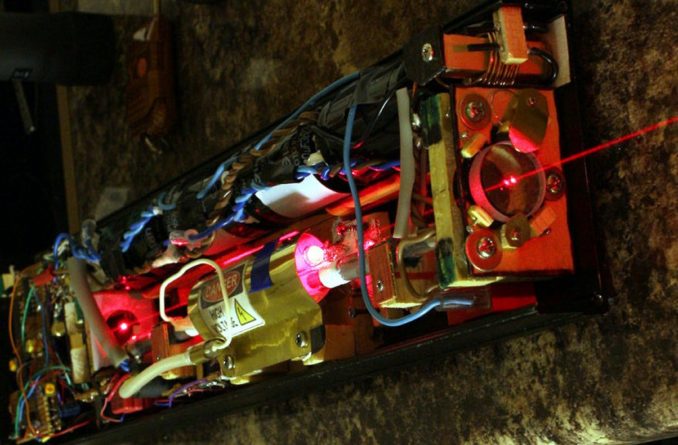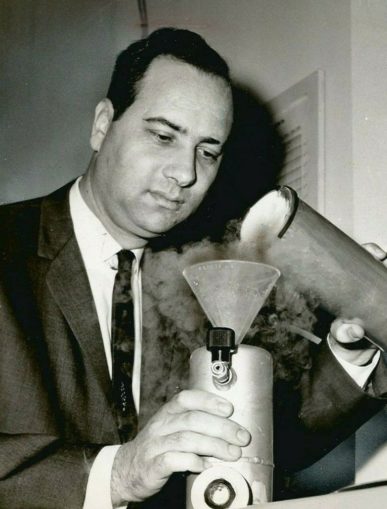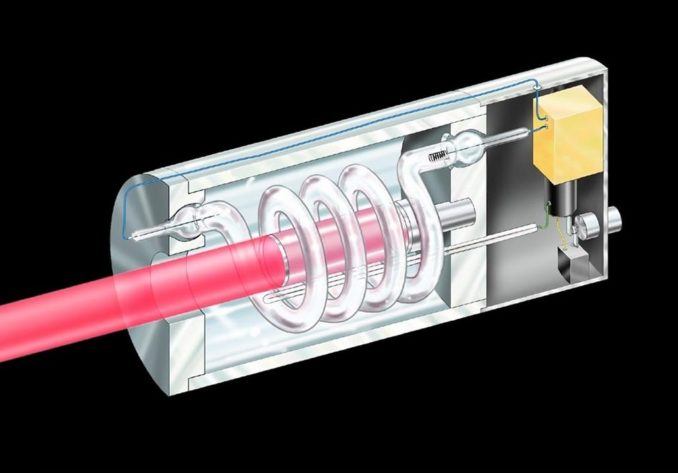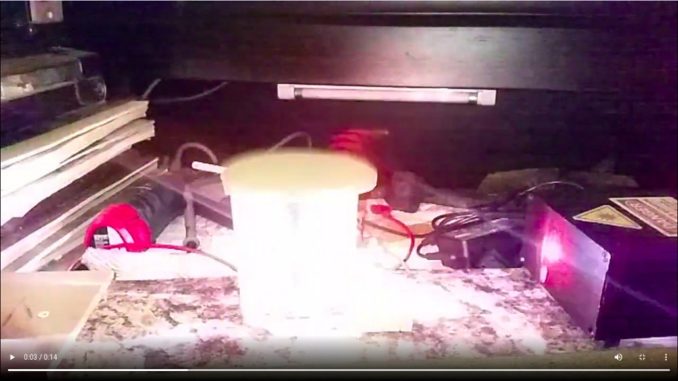
© Doc Mike Finnley, Going Postal 2020
Above photo: My ruby laser with a ‘mirror alignment laser’ just off to the right hand side of the photo. A small amount of smoke in the air makes the alignment laser-beam visible. In the center the front face of the ruby crystal can be seen glowing bright pink next to a high power flash-tube.
Sixty years ago humans added another way of making light to their list. From camp fires, candles, oil lamps, incandescent and florescent lamps was added laser light. This light is special. It consists, almost, of a single wavelength (or colour) and with all of the photons in phase (or in step with each other). Unlike other sources of light this means that it is bright, coherent and can be quite powerful! From high speed communication, advanced surgery and to measuring the distance between planets the human race took a large technological leap forward on May 16 1960.
Dr Theodore Maiman, The Laser Inventor

Unknown (Associated Press) / Public domain
Theodore ‘Ted’ Maiman the inventor of the ruby laser, the world’s first working laser. Back in the 1950s when lasers were still a theory something called the ruby maser was a real working device. One, it oscillated in a much lower part of the radio spectrum (about 10000 times slower than the ruby laser). Two, it needed to be super cooled. He strongly believed that pink ruby (a man made ruby crystal) could generate laser light at room temperature.
By the late 1950s the race was on to build a working laser. Large institutions such as IBM, MIT and Bell Laboratories threw millions of dollars into laser research. Some, like IBM, were working with pink ruby but were unsuccessful. By the end of the decade a lot of researchers were saying that pink ruby (or any ruby) could not be made to lase.
The Genius Of Simplicity
Working at Hughes Aircraft Company in 1960 Theodore was given the miserly budget of fifty thousand dollars for his laser research. He was convinced that pink ruby (essentially sapphire with a tiny amount of chromium added) could lase. The problem was supplying enough pumping light to the ruby. IBM had tried multi-thousand watt lamps focused onto small ruby crystals with no luck.
Where could he get this “pumping” light from?
In the 1940s Harold Edgerton, while working for Kodak, invented the xenon flash lamp. This consists of a glass tube filled with xenon gas and a couple of electrodes at either end. When a high voltage is applied to the lamp’s electrodes it emits an intense white light. I’m quite sure that we’ve all had our photograph taken with one and know how bright they are. Imagine a flash lamp three to four hundred times as powerful. That’s what’s needed to pump a ruby laser!
Theodore contacted General Electric that manufactured large xenon flash lamps. These flash lamps were helical in shape rather than the linear lamp that I am using. The lamp that he selected was so powerful that “it would set a piece of steel wool on fire if placed close to it!”.
The 1964 bond movie ‘Goldfinger’ has the famous laser scene. It’s to be noted that that “laser” mimics Maiman’s helical flash lamp in his original ruby laser.

US gov / Public domain
Above image: Theodore Maiman’s original ruby laser design. A small ruby ‘rod’ crystal sits inside the large helical flash lamp. Each end of the ruby is coated with a mirror finish. A small hole in one end of the rod’s mirrors allows laser light to escape. Later, this hole was replaced with a partially reflective mirror coating. The whole ensemble sits inside of a metal reflective cylinder. The unit measures no more than six inches in length and two inches in diameter.
For those of you interested in the filming of that Bond movie laser scene:
“No, Mr. Bond. I Expect You To Die!” The Red-Hot Story Behind ‘Goldfinger’s Laser Scene
And some interesting history of the flash lamp: Flashtube
Who Invented The Laser?
In 1958 Bell Laboratories filed a patent for a “potassium vapour” laser. This patent was granted in March of 1960, two months before Theodore had tested his ruby laser.
HA! Bell labs invented the worlds first working laser!
Not quite.
There are two types of patent that you can file in the US. One, for a real and working device. Two, for a teaching or “paper only” patent.
Guess which one Bell Laboratories filed in 1958? That’s right, a paper patent. This means that the patent should contain enough detail to build a working device without any extra invention or modification. By the May of 1960 no one had built a working laser from that patent and no one ever has. Bell Laboratories did not build the world’s first (working) laser.
At the time of writing, if you go to their web-site: From Maser to Laser
..and search that page for Theodore Maiman’s name, you’ll find it below a photograph of that patent (begrudgingly mentioned) in small print. They also have the cheek to describe the ruby laser without mentioning him!
Awards And Recognition Of His Invention
Luckily, not all institutions were as petty and jealous as Bell Laboratories in recognising the achievement of Maiman’s ruby laser.
His father wanted Theodore to study medicine and become a doctor. In 1994 he sort of granted him that wish. He was inducted as an honorary fellow of the Royal College of Surgeons of England, the only non-physician or non-royal member.
In 1984 he was awarded the Wolf Prize in Physics and, in the same year, The Japan Prize. He didn’t win the Nobel Prize, although he should have done.
Theodore passed away in 2007 but his wife, Kathleen, gave a speech at the ‘Laser fest 2010’ event where his original ruby laser was fired. Six Nobel Laureates witnessed the bright red laser spot. After the presentation a member of the Nobel physics committee confided to Kathleen, “Your husband should have gotten the Nobel. We made a mistake, but don’t blame me!”
In His Own Words
Theodore originally published his memoirs under the title “The Laser Odyssey”. In 2017 his wife re-published them with a new title, “The Laser Inventor”. And quite right, too!
Here are his own words from that day in 1960 when the world’s first working laser shone its new light:
It was the afternoon of May 16, 1960. It was time to confirm or deny all the fears of why the “ruby can’t work”. Or why “lasers can’t be made to work.”
The laser head was mounted on a workbench. The flash-lamp was connected to the power supply…The light output from the end of the ruby was directed through the Bausch and Lomb monochromator to a photomultiplier tube. The electrical signal from the photomultiplier was connected to a Hughes Memoscope.
Irnee D’Haenens and I were the only ones performing and observing the experiment.
We first took a test shot so that we could adjust the monitoring equipment. We turned up the power supply to about 500 volts. We fired the flash-tube. Indeed, we observed a trace on the Memoscope!
That trace was a recording of the red ruby fluorescence…We progressively increased the supply voltage, each time monitoring and recording the light output trace. As we did so, the peak output increased proportionately to the energy input and the decay time remained the same…So far, so good.
But, when we got passed 950 volts on the power supply, everything changed! The output trace started to shoot up in peak intensity and the initial decay time rapidly decreased.
Voila! This was it! The laser was born!
Above quote from “The Laser Inventor, Memoirs of Theodore H. Maiman”. Published by Springer, 2017.
Links To Some Short Videos Of My Ruby Laser In Action
I finish this article with a few short videos (less than a minute long) of my ruby laser. The laser took nearly a year to source the components, construct/develop and balance the optics to get it to work stably. A flash lamp exploded at one point in the development. It scared me so much that I nearly threw the whole thing away. The close to 1.5 million watts of energy stored in the capacitors blew the lid off of the laser’s case and made a bang so loud that it left a ringing in my ears for several minutes. Imagine setting a loud firework off indoors! A very sobering experience.
This video shows how an old smartphone captures the ruby laser light and how it looks to a DSLR camera. You can hear the DSLR shutter close after the laser fires and see the neat bright red laser spot at the end of the video. The phone’s camera sensor gets saturated by the flash and ruby laser light as it’s that intense. The DSLR – with a high f-stop – reveals the beautiful red laser spot. The shutter was open for about 3 secs. or 3000 milliseconds. The laser light lasted less than 1 millisecond (0.001 seconds) but look how bright it is compared to the incoherent flash-lamp spots – and they’re bright! The laser spot is about a quarter inch in diameter.
Here it’s burning a hole in some bin liner. I know, big deal! But it’s easier to see the burning with a light shining through it from behind and the thinness of this plastic makes it an ideal test target. The more circular the burn hole the better your mirrors are aligned and optics stable:
Finally, a little explosion. The phone’s camera shutter is running 8X faster so it’s a bit noisy and there’s no audio.
I placed a stick of charcoal inside of a whiskey glass which I then filled with a little butane from a gas stove lighter. The red laser light will not ignite the gas on its own but when it strikes the charcoal it burns with hot white and yellow sparks that can.
The laser is focused onto the charcoal with a glass lens, although at this distance it’s powerful enough to burn the charcoal without it:

© Doc Mike Finnley, Going Postal 2020
If you pause the video at the moment the laser fires, you get a good impression of the energy involved. Again, it saturates the camera’s sensor to white. Note the brilliant red light from the laser’s output.
© Doc Mike Finnley 2020
The Goodnight Vienna Audio file
Audio Player



